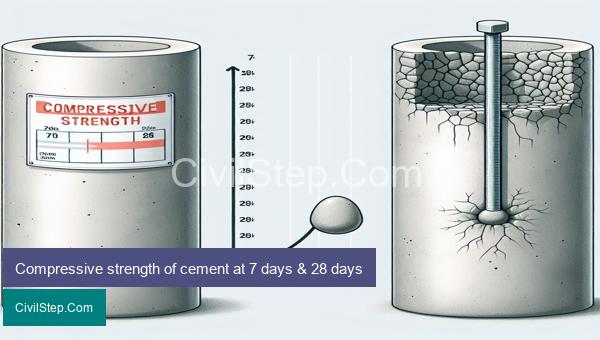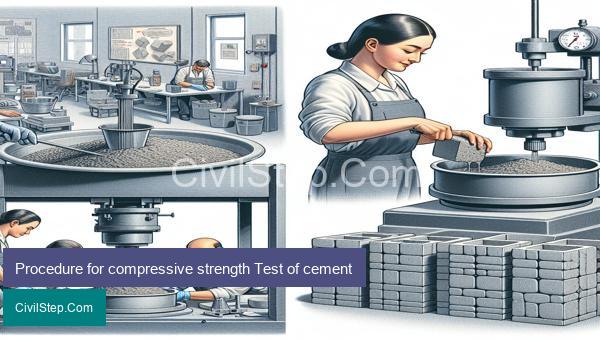
Cement is an essential building material, used in various constructions and structures around the world. Its strength is a crucial factor in determining the durability and stability of any construction project. The strength of cement is typically measured at specific time intervals, commonly at 7 and 28 days after the initial mixing. These time intervals are significant as they reflect the early and later stages of hydration, which greatly influence the overall strength of the cement. In this article, we will explore the factors that affect the strength of cement at 7 days and 28 days, and why monitoring this strength is important in the construction industry.
Compressive strength of cement at 7 days & 28 days

Compressive strength is one of the most important properties of cement and is used to evaluate its overall quality and performance. It is the ability of cement to resist being crushed under a specified load and is typically measured in megapascals (MPa). In general, compressive strength increases with time as cement continues to hydrate and gain strength.
The strength of cement is typically measured at two time intervals – 7 days and 28 days. These intervals are chosen because they represent the early and late stages of cement hydration, respectively. The compressive strength of cement at these intervals is an important indicator of its quality and is used to ensure that the cement used in construction meets project specifications and standards.
At 7 days, the compressive strength of cement is expected to be around 70% of its 28-day strength. This is because the hydration process of cement is still ongoing and has not yet reached its full potential at this stage. However, the 7-day strength is still an important parameter as it gives an indication of the early strength development of the cement.
At 28 days, the compressive strength of cement has typically reached its maximum potential, with some minor gains possible within the first three months. This is considered the standard time interval for measuring the compressive strength of cement. It is an important parameter for designers and contractors as it enables them to determine the suitability of the cement for its intended use.
Factors that affect the compressive strength of cement include the type of cement, water-cement ratio, curing conditions, and the presence of admixtures. Different types of cement have varying compressive strength and may also have different rates of strength gain. The water-cement ratio also plays a significant role as it affects the workability and strength of the concrete. Proper curing is essential to achieve optimal strength, as it ensures that the cement has enough time to fully hydrate and gain strength.
In conclusion, the compressive strength of cement at 7 days and 28 days is a crucial property that determines its usability and quality. It is a result of the hydration process and is affected by various factors such as type of cement, water-cement ratio, and curing conditions. Proper attention and testing of this parameter are necessary to ensure the durability and safety of any concrete structure.
Compressive strength of cement at 3,7 & 28 days.

Compressive strength is an important property of cement that measures its ability to resist axial (compression) forces. It is one of the most common tests conducted on cement to determine its quality and suitability for various construction applications.
The compressive strength of cement is typically measured at three different ages – 3 days, 7 days, and 28 days. Each of these ages represents a different stage of the cement’s hydration process, which can greatly affect its strength and overall performance.
At 3 days:
The compressive strength of cement at 3 days is an early indicator of its potential strength. At this stage, the cement is still in its early stages of setting and hardening. Generally, the strength of cement at 3 days is about 20-40% of its strength at 28 days.
At 7 days:
The compressive strength of cement at 7 days is an important milestone in the cement’s maturity stage. By this time, most of the cement’s hydration reactions have taken place, and it is starting to achieve its full strength potential. The strength of cement at 7 days is typically about 60-70% of its strength at 28 days.
At 28 days:
The compressive strength of cement at 28 days is considered as its ultimate strength. By this time, the cement has completed most of its hydration reactions and has reached its maximum strength potential. The strength of cement at 28 days is used to determine its grade and quality, and it is the most commonly used age for cement strength specification.
Factors Affecting Compressive Strength:
There are several factors that can affect the compressive strength of cement, including:
1. Water-cement ratio: The amount of water used in the cement mix has a significant influence on its strength. A higher water-cement ratio can result in lower strength, as it can hinder proper cement hydration.
2. Type and quality of cement: Various types of cement, such as Portland cement, Rapid Hardening cement, and Low Heat cement, have different strengths at different ages.
3. Curing conditions: Curing is the process of maintaining proper moisture levels in the cement during the early stages of its setting and hardening. Proper curing is crucial to achieve desired strength.
4. Aggregate properties: The quality and type of aggregate used in the cement mix can also affect its ultimate strength, as it provides support and helps distribute the load evenly.
Significance of Compressive Strength:
The compressive strength of cement is an essential factor to consider in various construction applications. It determines the load-carrying capacity, durability, and overall performance of cement in a particular structure. Higher strength cement is often used in high-rise buildings, bridges, and other critical structures, where it is subjected to heavy loads and forces.
In conclusion, compressive strength is a vital property of cement that determines its quality, suitability, and performance. The strength of cement at 3 days, 7 days, and 28 days provides valuable information for engineers to design and construct safe and durable structures. It is important to conduct proper quality control tests on cement to ensure its strength meets the required specifications for a particular project.
Compressive strength test of cement

Compressive strength test is one of the most important tests conducted on cement to determine its suitability for use in construction projects. This test measures the ability of cement to resist compression, which is a critical factor in determining its overall strength and durability.
There are various standards and methods used for conducting the compressive strength test of cement, such as ASTM C109, EN 196-1, and IS 4031. However, the basic principle of the test remains the same.
The test specimen is prepared by filling a cube-shaped mold with freshly mixed cement paste. As per the standards, the size of the cube is 70.6 mm on each side. The mold is then compacted by hand or machine to ensure there are no voids or air pockets in the specimen. After compacting, the surface of the mold is smoothened, and excess cement paste is removed.
Once the mold is prepared, it is then covered with a damp cloth and kept in a temperature and humidity-controlled environment for 24 hours. This curing process helps the cement to attain its maximum strength potential.
After 24 hours, the specimen is taken out of the mold and placed in a compression testing machine. The load is applied gradually and uniformly until the specimen fails. The load is measured in kN (kilonewton).
The compressive strength of cement is calculated by dividing the maximum load applied on the specimen by the cross-sectional area of the specimen. It is expressed in N/mm² (Newton per millimeter square). The test is typically repeated three times, and the maximum load is recorded for each specimen. The average of these three values is taken as the compressive strength of the cement.
The minimum compressive strength requirement for different types of cement varies according to the intended use, as specified in the standards. For instance, Ordinary Portland Cement (OPC) should have a minimum compressive strength of 53 N/mm² after 28 days, while Portland Pozzolana Cement (PPC) should have a minimum strength of 43 N/mm² after 28 days.
Factors like temperature, humidity, and curing conditions can affect the compressive strength of cement. Therefore, it is essential to maintain proper curing conditions during the test to ensure accurate results.
In conclusion, the compressive strength test of cement helps to ensure that the cement used in construction projects meets the required strength standards. It is crucial to conduct this test to ensure the structural integrity and durability of the concrete elements. As a civil engineer, it is important to understand and adhere to the standards and procedures for conducting this test for accurate and reliable results.
Procedure for compressive strength Test of cement

The compressive strength test of cement is an essential part of its quality control process. This test determines the ability of cement to resist compressive loads and is crucial in ensuring the safety and durability of concrete structures.
The procedure for conducting a compressive strength test of cement is as follows:
1. Sampling: The first step in the process is to obtain a representative sample of cement from the batch that is to be tested. The sample should be collected from multiple bags or from different portions of a bulk stockpile to ensure an accurate representation of the entire batch.
2. Preparation of cement paste: A cement paste is prepared by mixing cement and water in a predetermined ratio. The ratio is usually specified by the national standards or the manufacturer’s recommendations. The mixing should be done using a mechanical mixer for a specified duration to ensure uniformity.
3. Filling the molds: Once the cement paste is prepared, it is poured into standard molds in layers and compacted using a vibrating table. The top surface of the molds is then smoothed using a steel trowel.
4. Curing: The filled molds are then covered with a damp cloth or plastic sheet to prevent evaporation and loss of moisture. The molds are placed in a curing tank or a moist cabinet at a temperature of 27 ± 2°C for 24 hours.
5. Drying: After the 24 hours of curing, the molds are removed from the curing tank and stored in a moist cabinet at 90 ± 2°C for 24 hours. This process helps in accelerating the hydration process and strengthens the cement paste.
6. Testing: After the drying period, the molds are carefully removed, and the specimens are then placed in a testing machine. The testing machine applies a gradually increasing load until the specimen fails. The applied load and the corresponding deformation are recorded.
7. Calculation of compressive strength: The compressive strength of the cement is calculated by dividing the maximum load applied to the specimen by the cross-sectional area of the specimen. The result is reported in megapascals (MPa) or pounds per square inch (psi).
8. Reporting: The results of the compressive strength test are then reported to the relevant authorities or the manufacturer. These results are crucial in determining the quality and performance of cement in construction.
In conclusion, the compressive strength test of cement is a standard procedure that must be followed to ensure the quality and reliability of cement in construction. It is important to perform this test regularly to ensure that the cement used in construction meets the required standards and specifications.
Conclusion
In conclusion, understanding the strength of cement at 7 days and 28 days is crucial in ensuring the structural integrity of any construction project. While the initial strength at 7 days may provide a rough estimate of the cement’s potential, it is the strength at 28 days that truly determines its long-term durability. Proper curing and testing methods, as well as the use of high-quality cement and admixtures, are key factors in achieving optimal strength. By closely monitoring the strength at both time points, engineers and contractors can make informed decisions and adjustments to ensure the success of their projects. Ultimately, a strong and reliable concrete mix at 7 days and 28 days is essential for safe and long-lasting structures.
